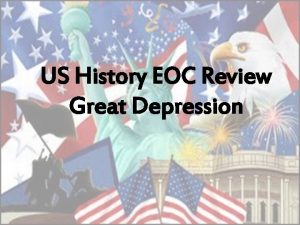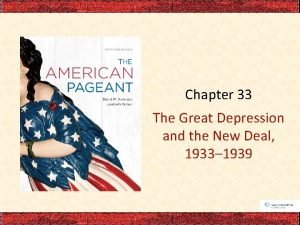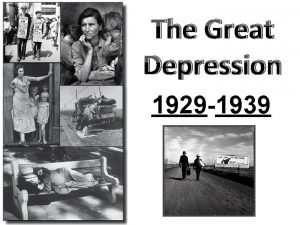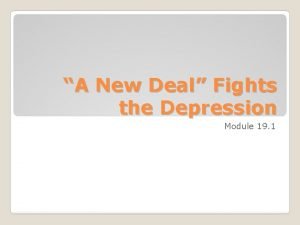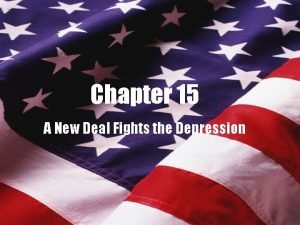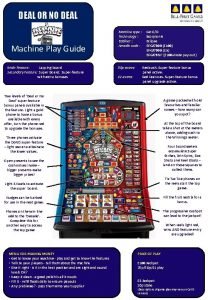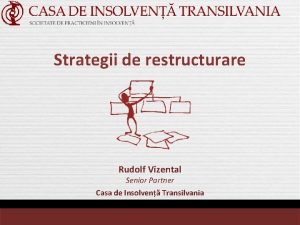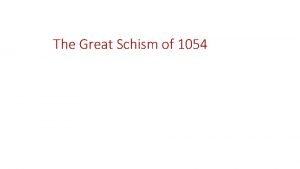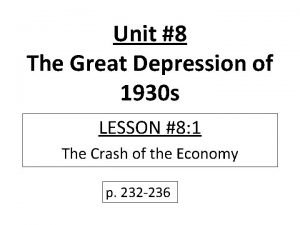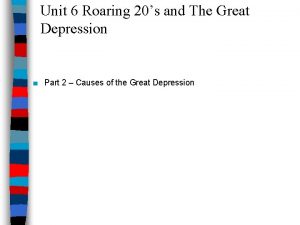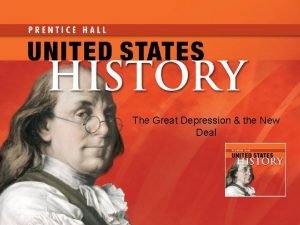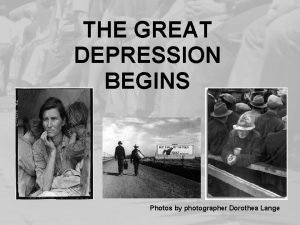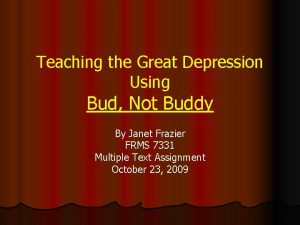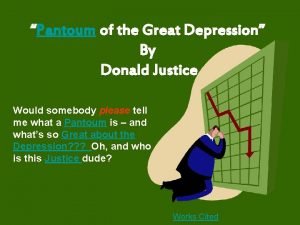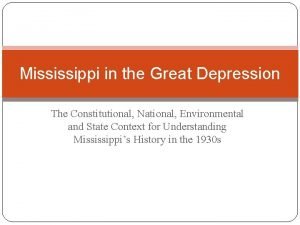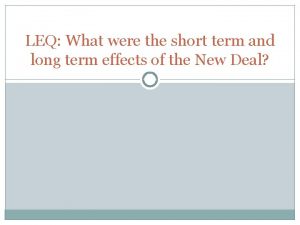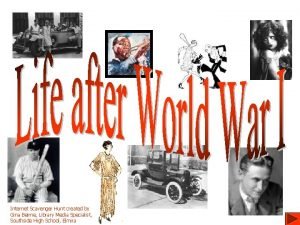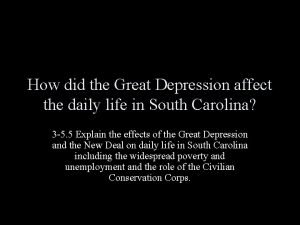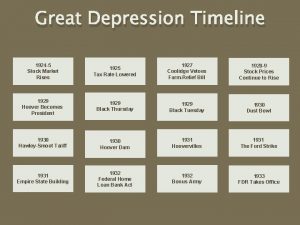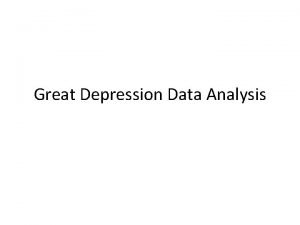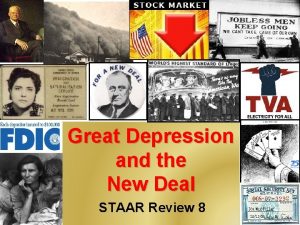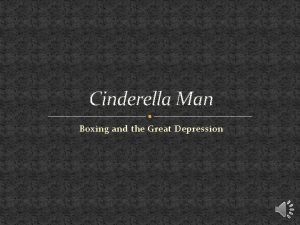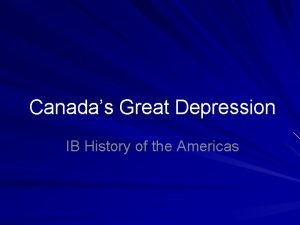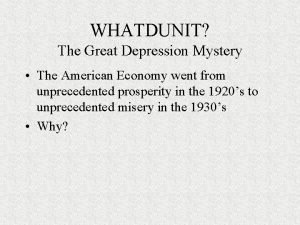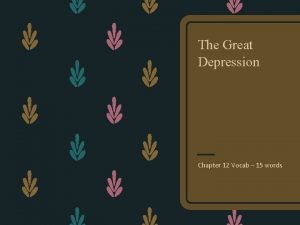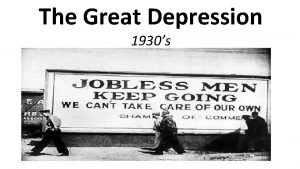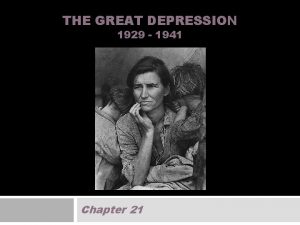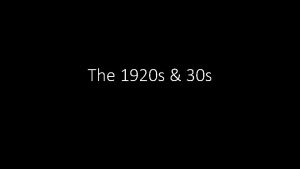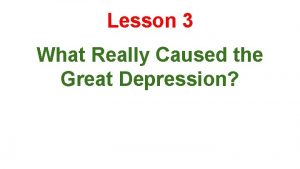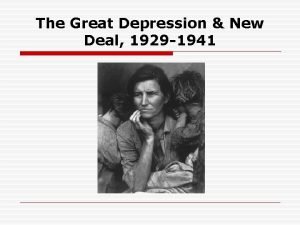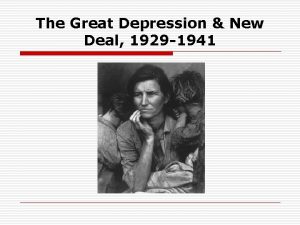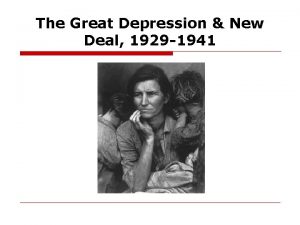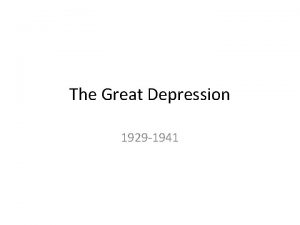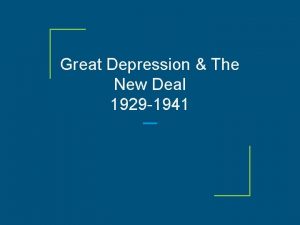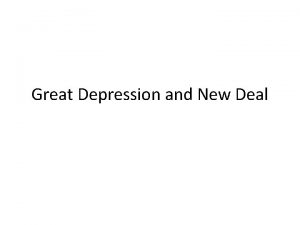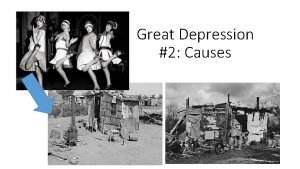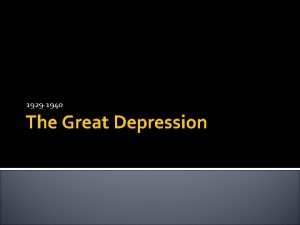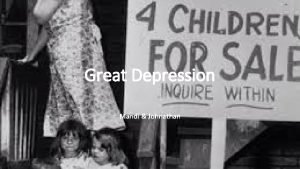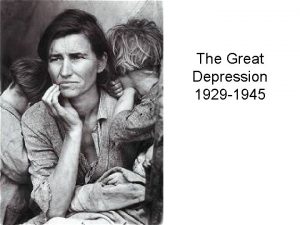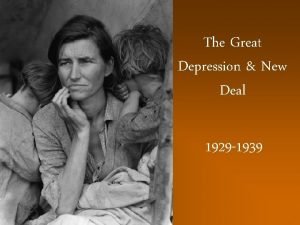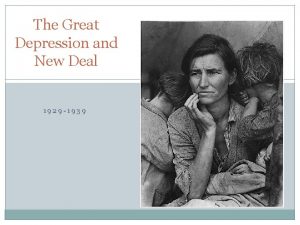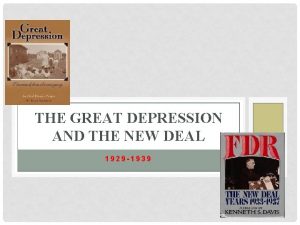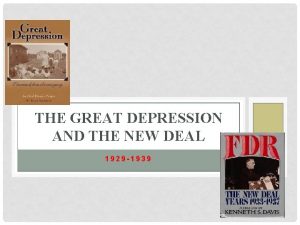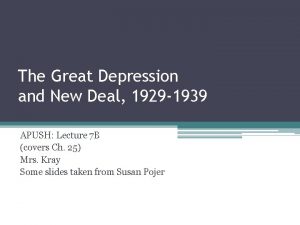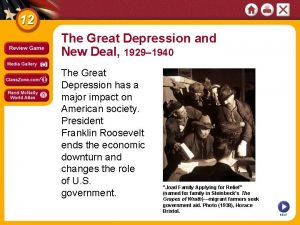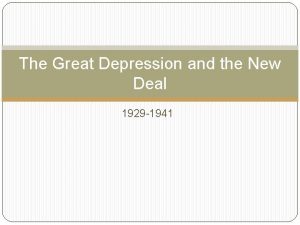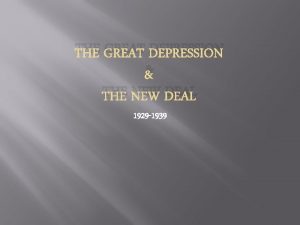The Great Depression New Deal 1929 1941 Origins









































- Slides: 41

The Great Depression & New Deal, 1929 -1941

Origins and Causes □ □ □ □ □ Extreme wealth inequalities Unwise borrowing and too much debt Overproduction and uneven distribution Ballooning stock market Too much speculation & buying on margin (borrowing money from a broker to purchase stock) Stock Market crash was trigger Banks lacked money, people lost savings, debts were called in Production stopped, workers fired, no income, consumption declined, no profits, more workers fired Smoot-Hawley Tariff dampened commerce globally and intensified Depression.

President Herbert Hoover’s response was to do little (Laissez-faire: let things take their course w/o interference) □ Only state & local, not Federal, governments should provide relief to the needy □ Self-help & volunteerism □ Self-help cooperatives As Depression deepened: □ Federal loans to banks, states, & local governments

Hoovervilles

The Bonus Army/March WWI veterans Gov’t denied early service bonus Marched on Washington (1932) Camped around White House & Capitol Military led by Gen. Douglas Mac. Arthur evicted veterans from D. C. □ Anger at Hoover’s gov’t □ Deep class divisions □ □ □ https: //www. youtube. com/watch? v=s. NOs. IB 5 VMSQ

Roosevelt and the New Deal □ □ □ Franklin Delano Roosevelt (FDR) ”First Hundred Days” Programs to address the Depression “Relief, Recovery, Reform” Deficit spending/Debt Consume our way out of the depression Role of government enlarged

Immediate Responses, 1933 □ “Bank Holiday” & Emergency Banking Act □ Federal Emergency Relief Act (FERA) ■ Federal funds for relief □ National Industrial Recovery Act (NIRA) ■ Fair work and competition codes ■ Labor rights

Bank run: people rushing to the bank to withdraw their savings.

Financial System □ Federal Deposit Insurance Corporation (FDIC) ■ Insured individual bank deposits □ Securities and Exchange Commission (SEC) ■ Regulated trading practices in stocks and bonds

New Deal Programs Civilian Conservation Corps (CCC) □ Soil Conservation Service □ Building roads, park trails □ Planting trees □ Irrigation and range management □ Targeted young men age 18 -25 who were housed in work camps □ http: //www. youtube. com/wat ch? v=qol. Pq. XNGW 3 I

Public Works Administration (PWA) -Managed all large public works projects that used skilled labor, putting millions back to work. -Set work hours and minimum wage -Didn’t allow child labor

Tennessee Valley Authority

TVA (1933) □ One of the most innovative ideas of Roosevelt’s recovery plan: He asked Congress to create “a corporation clothed with the power of government but possessed of the flexibility and initiative of a private enterprise. ” □ Flood control, Electricity, Irrigation, Jobs □ Still functioning today

Second New Deal (1935 -1938) □ After pulling back on federal government spending in 1934 over concern about the rising national debt and fear that Americans would become too dependent on government-provided jobs, FDR saw unemployment shoot up again sharply and the recovery stall. □ In 1935, he launched another series of programs and reforms to speed up the recovery, provide economic relief/security to more Americans, and ensure his re-election in 1936.

Works Progress Administration (WPA) □ Biggest agency □ 1935 employed 8 million and $2 billion fund ■ Bridges, reservoirs, irrigation, sewage, schools, playgrounds, education, training □ Work Programs paid minimum wages, pulling people off charity and soup lines □ “We Work Again” ■ http: //www. youtube. com/watch? v=Gk 0 Sp TOi 9 Aw

Propaganda/Education □ □ Government Promotional Film http: //www. youtube. com/watch? v=Aq 5 Ui. Gdje 8 U

1935 Social Security Act □ Safety net for all Americans (unemployment system, disability insurance, old-age pension, child-welfare benefits) □ Percentage of paycheck (payroll tax) □ Based on shorter life-span □ Intended to supplement (not replace) income

Wagner Act, officially National Labor Relations Act (1935) □ Single most-important piece of labor legislation enacted in the U. S. in the 20 th century. □ Main purpose was to establish the legal right of most workers (excepting agricultural and domestic workers) to organize or join labor unions and to bargain collectively with their employers. □ Prohibited employers from engaging in unfair labor practices, and set up a National Labor Relations Board (NLRB) with the power to hear and resolve labor disputes.

Fair Labor Standards Act of 1938 (Wage & Hours Bill) FLSA establishes: • Federal Minimum Wage • Forty-hour Work Week • Overtime Pay FLSA prohibits: • Oppressive child labor

The Dust Bowl □ 1930’s economic and environmental disaster in Southern Plains states □ Overproduction, monocrops □ Farmers plowed up native grasses to meet needs of booming wheat market □ Soil exhaustion, soil erosion □ Drought and winds = dust storms □ 1935 “Black Blizzard”: Winds blew soil from CO and NE, blackened the sky across the plains, into the East Coast and Atlantic Ocean

Responses □ Killed millions of animals, destroyed millions of tons of food □ Soil Conservation Service □ Taylor Grazing Act

Migrants: Okies □ Poor whites and sharecroppers □ Evicted from homes in OK, TX, MI, ARK □ Going to CAL □ L. A. Police Chief “bum blockade”

Mexican and Okie Farmworkers

Problems with New Deal □ Favored large industries and business □ Hurt some small farmers □ Local agencies administered relief and ran programs □ Relief based on race: scaled payments □ Criticism of new deal: http: //www. lhs. rcs. k 12. tn. us/teachers/pughc/Po werpoint/New%20 Deal/The%20 New%20 Deal%2 0 and%20 FDR. swf

Mexican Repatriation - Nearly 1 million Mexicans and Mexican-Americans sent to Mexico - L. A. County deported 12, 000 - Colorado deported 20, 000

Indian Reorganization Act (1934) ■ Economic & political assistance ■ Business Councils ■ Tribal Constitutions ■ Bureau of Indian Affairs, Interior Dept ■ Although the IRA was meant to reverse assimilation policies & provide tribes with greater autonomy, some rejected it

Women □ Eleanor Roosevelt □ Work: women made less money than men and were discouraged from taking jobs men needed. □ Patriotic home: conserve, recycle, help America “as a woman” (sewing, canning, etc. )

African Americans □ Unemployment rate reached 50% □ Sharecropping □ Jobs in gov’t, “Black Cabinet” □ Mary Mc. Cloud Bethune □ 100, 000 blacks evicted by AAA □ No loans from FHA □ http: //www. youtube. com/watc h? v=Gk 0 Sp. TOi 9 Aw

Criticisms of New Deal Claims: □ Gave Federal Government too much power □ Piled up national debt □ Telling businesses how to operate was destroying our free enterprise system □ Undermined individualism and promoted Socialism □ Focused too much on helping “big business” and didn’t tackle wealth inequalities

Major Critics □ Senator Huey Long □ Father Charles Coughlin □ Liberty League

“Share the Wealth” □ Huey Long □ Populist Governor and Senator from Louisiana □ Use of radio and sensational claims □ Rhetoric of poverty / class tensions □ “Share the Wealth” Plan □ Social Justice https: //www. youtube. com/watch? v=0 i. Gxjtl. KVok&ebc=ANy. Px. Kqzc. Q_UIa. TZy. Ltwaub. G 6 IVezw. C 3 Hcqbl Rx 1 c 7 ftsb. B 3 i 3 iad 1 Ykn. Uf. EYm. XBqq-y. Pb 3 ee 1 Ltueob. I-e. Mi. Cdd 2 Hbts 9_Ukg (start video 3: 40)

Father Coughlin utilizes Radio □ A Catholic priest from Detroit who outwardly criticized the New Deal because he thought its reforms and relief efforts were too moderate. □ Began broadcasting a weekly radio show in 1930 that amassed a following of 40 million listeners. □ He blamed the Great Depression on Wall Street, crooked financiers, and Jews. □ Demanded higher taxes on the rich and nationalization (government takeover) of the entire American banking system.

Liberty League □ Group of business leaders and anti-New Deal politicians of both parties □ Alarmed by growing deficit spending and government intervention in business, their purpose was to organize opposition to the New Deal and “teach…respect for the rights of persons and property. ”

Public Art and Culture □ Federal Writers Project □ Theater □ Oral histories of slavery, folk lore, Indian stories, Mexican Revolution, cowboys, frontier life, etc □ National cultural resources and heritage □ Federal Arts Program ■ http: //www. youtube. com/watch? v=PKsm 3 Sm BBKU&feature=related

Federal Theatre Project

Writer’s & Theater Project

WPA Posters

Travel through the West

New Deal Work Mural

End of the Depression □ Federal spending on an unprecedented level failed to stop it, but buffered its effects on the public. □ Expanded role of the federal government in the American economy and increased power of Executive Branch □ Made the federal government into a “broker state” between labor and capital, and other competing economic interests □ Social programs and “safety net” □ Brought fed gov’t into lives most Westerners □ WWII ended the Depression

Comparisons with the Present? Wealth inequalities Deregulation Bad Home mortgages High level of individual debt Inflated costs & uncontrolled speculative investments in commodities □ Collapse of investment-debt-loan system A Vicious Cycle: □ □ □ ■ Retraction of loans, increase in job losses, fall in investments, layoffs, decline in consumption, reduced production, layoffs, no consumption…
 Great depression vocabulary
Great depression vocabulary What is the main idea of this cartoon?
What is the main idea of this cartoon? Chapter 33 the great depression and the new deal
Chapter 33 the great depression and the new deal Great depression 1929
Great depression 1929 Stock market crash 1929 great depression political cartoon
Stock market crash 1929 great depression political cartoon A new deal fights the depression
A new deal fights the depression Chapter 15 section 1 a new deal fights the depression
Chapter 15 section 1 a new deal fights the depression A great deal vs a great many
A great deal vs a great many Deal or no deal machine
Deal or no deal machine Rudolf vizental
Rudolf vizental Great stock market crash 1929
Great stock market crash 1929 One of the most effective vegetable protein
One of the most effective vegetable protein What was the deal breaker in the great schism
What was the deal breaker in the great schism Rarig great depression
Rarig great depression Great depression
Great depression The ingenious quarterback
The ingenious quarterback Foreclosure great depression
Foreclosure great depression Five effects of the great depression
Five effects of the great depression Five effects of the great depression
Five effects of the great depression How did the great depression impact the world
How did the great depression impact the world What is the dawes plan
What is the dawes plan Bud not buddy
Bud not buddy Donald justice pantoum of the great depression
Donald justice pantoum of the great depression Summary of great depression
Summary of great depression What is deflation
What is deflation Okies great depression
Okies great depression The great depression leq
The great depression leq Roaring twenties scavenger hunt answers
Roaring twenties scavenger hunt answers How did the great depression affect daily life
How did the great depression affect daily life What caused the dust bowl
What caused the dust bowl Great depression causes
Great depression causes Brief summary of the great depression
Brief summary of the great depression Hoovervilles
Hoovervilles Birth rate during the great depression
Birth rate during the great depression Overspeculation great depression
Overspeculation great depression Great depression vocab
Great depression vocab Chapter 14 the great depression begins vocabulary
Chapter 14 the great depression begins vocabulary Great depression
Great depression Http://www.history.com/topics/great-depression
Http://www.history.com/topics/great-depression Hawley-smoot tariff great depression
Hawley-smoot tariff great depression Module 9 lesson 2
Module 9 lesson 2 Lesson 3 effects of the great depression
Lesson 3 effects of the great depression

